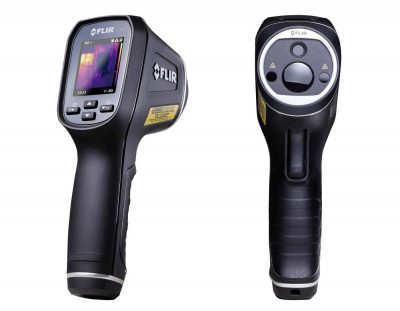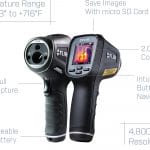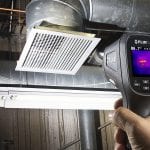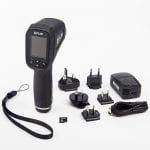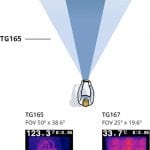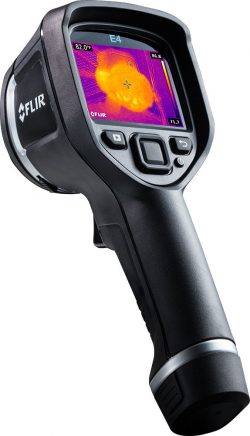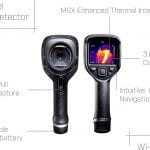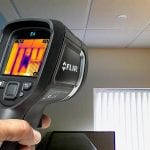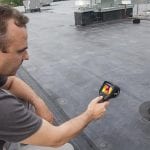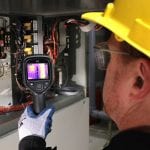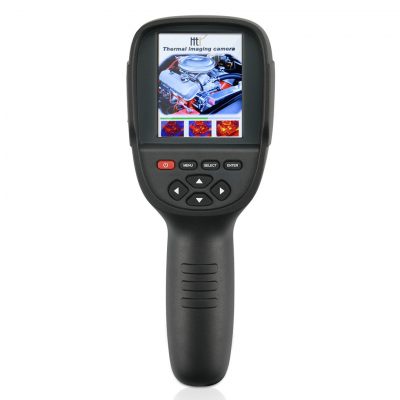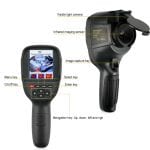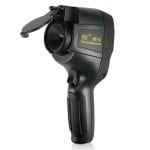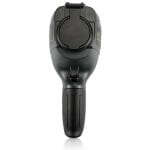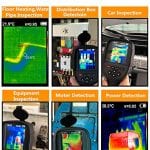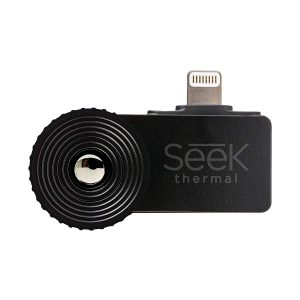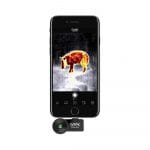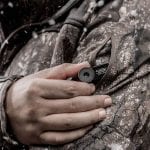Best Thermal Imaging Cameras 2022
Best Thermal Imaging Camera Review
Thermal imaging cameras have now become a norm in society, which leaves a lot of people asking: what is the best thermal imaging camera available on the market? These handy devices have come a long way from their initial military use, which they were originally invented for during the Korean war. They are now used in all sorts of professions to complete a range of different tasks.
For example, firefighters use thermal imaging cameras to see through smoke and identify the location of fires and law enforcement use thermal imaging to surveillance and locating purposes in order to apprehend suspects. More commonly, thermal imaging cameras are now used in day to day activities of construction, maintenance, repair and inspection workers. In these professions, thermal imaging cameras are used to do a range of different tasks including identifying discrepancies in insulation, weak spots or potential leaks in piping or inspect the overall condition of properties and building works.
At Wonkee Donkee we review all kinds of power tools and gadgets that are used by professionals, it is our job! Our goal is to trial and test all tools on all their different features to help you decide which are the best for you. We also spend time scouting the internet for other real customer reviews so that we make sure we aren’t giving you a one-man-band review of each tool. In this article, we have reviewed the best thermal imaging cameras from their affordability, specifications and ease of use to help you decide which is best for you!
FLIR TG165 Spot Thermal Imaging Camera
If you are familiar with thermal imaging technology then you will instantly recognise the company FLIR as one of the industry leaders with innovative and high-quality products. The FLIR TG165 is no exception and takes the top spot in our best thermal imaging camera review. This thermal imaging camera is designed to be a great no-nonsense thermal camera that just gets the job done.
It contains all the basic features you need from a thermal imaging camera to monitor and capture thermal images easily, with an added realtime thermometer to monitor temperatures. With a thermal temperature range of -13 to 716 degree Fahrenheit (-25 to 380 degree Celsius) and a thermal sensitivity of 0.15 degree Celsius, it is great thermal imaging camera for a variety of applications. It really is a no-nonsense thermal imaging camera which is relatively affordable, especially in comparison to more premium thermal cameras.
As we mentioned the FLIR TG165 is not a gadget full of added features, it is built for the simplicity of taking thermal images and temperatures quickly and easily. FLIR have included two laser pointers from this handheld thermal imaging camera which project on to the area you want to capture. This feature also allows you to make fast and accurate measurements of any objects you are scanning from switches to circuit boards, reducing the lack of precision that comes with guesswork. It also has a field of view of 50-degrees which is makes it easy to scan an entire wall in just one thermal image. This good field view range makes it so much easier when using a thermal imaging camera to locate missing insulation in walls or ceilings for example.
FLIR have designed this the TG165 thermal imaging camera with usability in mind too. It is handheld and no training or prior knowledge is needed. You simply point the device at the area you wish to capture and pull the trigger to create a thermal image. These thermal images can be taken in any of the devices colour options of iron, rainbow or grey. They are then saved on the built-in 8GB SD card which can hold up to 75,000 thermal images, transferable to other devices by USB or using an SD card reader. If 8GB storage is not enough, the FLIR TG165 can accommodate any SD card up to 32GB.
The main drawback of the FLIR TG165 is its screen size and resolution but been as its one of the most affordable thermal imaging cameras on the market, this is no real surprise. The image resolution is only 80 x 60 which is good enough but if you want or need more than a high-end thermal imaging camera may be more suitable.
Our Verdict
As nice as it is to have a tool that is all singing all dancing with an array of added features, sometimes you can’t beat pure simplicity. That’s exactly what FLIR have created with their TG165 thermal imaging camera and at Wonkee Donkee we love it. This thermal imaging camera has been designed to be no-nonsense and anyone can pick it up, point it and pull the trigger to capture a thermal image. We also really like the laser pointers which provide the context of measurement as well as the wide view range of 50 degrees.
The storage is more than enough and the battery life allows you to use it uninterrupted for 5 hours. If you are looking for the best thermal imaging camera for electricians, construction workers, property inspectors or HVAC troubleshooting then you really cannot go wrong with the FLIR TG165. At Wonkee Donkee if we had to sum it up in three words we would say affordable, simple and efficient.
FLIR E4 Compact Thermal Imaging Camera
As mentioned in the FLIR TG165 review, FLIR is one of the best manufacturers of thermal imaging cameras so it is no surprise to see that they also take the second spot of our best thermal imaging camera list with the FLIR E4. The FLIR E4 is a high-quality professional thermal imaging camera which uses a patented ‘MSX Technology’ to provide advanced high-resolution radiometric thermal images. This cutting-edge technology allows you to easily identify a range of problems including hot or cold zones, overheating circuits, areas subject to moisture damage or condensation and much more.
The specifications of the FLIX E4 are also impressive with its 3-inch colour LCD screen which clearly displays the thermal images to the user. It also includes a 640 x 480 digital camera which captures images at the same time as the infrared camera. It has a temperature range of -4 to 482 degrees Fahrenheit (-20 to 250 degrees Celsius) which is accurate to a thermal sensitivity of 0.15 degrees celsius. The onboard lithium-ion rechargeable battery has a decent life of 4 hours but also comes with the added benefit of being removable so it can be swapped if you have a spare nearby.
FLIX has also made the E4 thermal imaging camera simple to use again using a simple point and trigger mechanism to capture thermal images. What makes the thermal images that the E4 model catches so impressive is the radiometric JPEG storage which includes temperature information when the images are saved. In addition, you can use the FLIR reporting software to annotate and add extra information to images such as analysis of the data in order to help in the reporting process for the company or client you are working for. You can capture thermal images in iron, rainbow or grey from a selection on the colour palette and overlap these images on digital images taken at the same time. These images can then be transferred to other devices easily using the USB cable and software included.
The FLIX EX thermal imaging cameras all come with their award-winning 10-5-2 warranty which provides you peace of mind when making a purchase. This warranty covers parts and labour for 2 years, the battery for 5 years and the infrared detector for a full 10 years.
Our Verdict
At Wonkee Donkee we do admit that we have a little soft spot for FLIR products but it is hard not to when you test out their thermal camera range. They literally offer everything from a more affordable thermal imaging camera in the FLIR TG165 to more premium thermal imaging cameras such as the FLIR E4 and the rest of the FLIR EX range. There is a long list of what we like about the FLIR E4 thermal imaging camera including its compactness, ease of use, versatility, patented ‘MSX technology’, picture overlapping and more. It really is a great professional thermal imaging camera which is perfect for electricians, roofers or plumbers to quickly identify issues in order for repairs to be carried out quickly and efficiently.
Admittedly, it is not the cheapest thermal imaging camera available but we do believe it is good value if your budget is big enough. The one thing we would have liked the E4 to include for this price is a slightly better resolution screen than 80 x 60. However, there is a whole FLIX EX series which includes an array of higher specifications.
HT-18 IR Resolution Infrared Thermal Imager
You may not have heard of HTI yet but you will definitely be hearing about them if you continue to have an interest in the thermal imaging industry. If you read up on HTI you can see their mission is to be customer-focused and provide the latest in thermal technology for affordable prices. If you are looking for a new thermal imaging camera then maybe the HT-18 thermal imager might just be the first of many thermal technology tools you purchase from HTI. As we just mentioned HTI focus on producing affordable thermal imaging cameras and the HT-18 is a prime example of this.
The specifications you get for the price are outstanding, with a lot of them are only likely to be found in much more expensive thermal imaging devices. The HT-18 thermal camera can produce images at a thermal resolution of 220 x 160 which is extremely high-quality for its price. The temperature range is also incredible with -4 to 572 degrees Fahrenheit (-20 to 300 degrees Celsius) which is better than much more expensive thermal imaging cameras. The thermal sensitivity is a commendable +/- 2.5 degrees Fahrenheit.
These captured thermal images are displayed on the 3.2-inch full colour display screen and their clarity is aided by a built-in .3 megapixel visible light camera which enhances the contrast of thermal images. If that is not enough for you, you can choose between five different colour palettes including iron red, rainbow, black and white, cold colour or white and black. Images can also be placed over and blended with other images to provide a more insightful final product to the user. All of the images captured and saved directly on to the 3GB SD card which is included within the device. These can be transferred to a different device with the included USB lead or by taking out the SD card and using an SD card reader.
There is a long list of all of the different things you can do with the HT-18 including inspections of properties, vehicles, machines, piping and much more in order to assess their physical state. In addition, the HT-18 can also be used as a problem solver to identify any issues or areas of weakness such as a heat leak or a build-up of moisture. HTI also offers a range of after sales services including a 60-day money back guarantee if you are unhappy with your purchase, a 24-month full warranty and a lifetime of technical support.
Our Verdict
Although HTI is not one of the most well known thermal technology brands at the moment, at Wonkee Donkee we really think this is about to change. We have tested and reviewed several of their products and all of which so far have combined a great balance between affordability and high-quality. The HT-18 is probably our favourite product that we have reviewed from HTI so far. When comparing with models of a similar price it is difficult to believe how much good the specifications of this model are.
If you are looking for a high-quality thermal imaging device without having to spend the money on top-end models then the HT-18 should definitely be included in your considerations. At Wonkee Donkee we think that this is the best affordable thermal imaging camera if you need a device that does more than the FLIK TG165.
Seek Compact XR Extended Range Thermal Imager
This is a bit different from the thermal imaging cameras we have reviewed so far in that it is an add-on device as opposed to its own tool. The Seek Compact XR thermal imager is compatible with both iOS and Android smartphones, utilising their screen to display the data picked up from the thermal camera. One area that this Seek thermal imager excels is the range and distance in which it picks up thermal energy, displaying clear thermal images. Standard Seek thermal imaging cameras can capture high-quality thermal images from up to 1,000 feet away, whilst the XR model can do this at 1,800 feet away. At this point, it is probably important to mention that Seek has built their compact series seemingly more aimed at alternative uses such as hunting. However, there is no stopping using these in contracting or project work.
The specifications of the Seek Compact XR are also good with a temperature range of -40°F to 626°F (-40 to 330 degrees Celsius) so it is more than capable of completing maintenance, inspection and other tasks around properties. It also has a sensitivity of 1°F ensuring that you are getting precise measurements of the levels of the temperature of the area you are targetting. To add to this the image resolution of the thermal camera is 206 x 156, which creates clear thermal images whereby it is easy to distinguish differences in temperature.
The fact that the Seek Compact XR uses the screen of the smartphone to display the thermal image means that you get the benefit of a high-resolution viewing screen. There are also additional features such as threshold settings which allows you to limit what temperatures are picked up. This makes it easy to isolate what you are trying to capture and take higher-quality thermal images.
Another benefit of the Seek Compact is XR is given away in its name and it is how small and lightweight the device is. The actual thermal camera fits snugly into the port of the phones charger input and is so lightweight it is barely noticeable when you are holding the phone. One of the reasons for this is that the device does not carry its own battery and instead uses the phone battery in order to operate.
This saves you worrying about charging two different devices, but also means that you should keep an eye on your phone’s battery levels in order to ensure you can continue to use both devices. The Seek Compact XR also comes with a handy waterproof case which has a keychain attached. This protects the device when not in use as well as making it easier to carry around.
Our Verdict
At Wonkee Donkee we love it when manufacturers think out of the box and create tools that are unlike any others on the market. That is why we like the Seek Compact XR thermal imaging camera. From concept to design this is just a really good thermal imager, with the range of distance it provides really offering an alternative to classic models. As you can see from the specifications it is also a powerful device with a decent temperature range and sensitivity. What we also really liked when we tested it was the threshold settings allow you to only capture areas or objects within a certain range. Saying all this, there was a couple of things that the Seek Compact XR lacked. The absence of a digital camera meant that duplicate pictures could not be taken and overlaid. The app that accompanies the thermal camera is also mediocre only offering minimal colour palette options and no extra settings.
So the main benefits of the Seek Compact XR are the range at which it can capture thermal images and its small size. At Wonkee Donkee we think that makes this a serious contender if you need a good quality thermal imager then you can use on the go without having to get near to hard to reach places. For example in construction, this thermal imager will allow you to measure thermal energy from a reasonable distance during the building process in order to ensure the safety of a project. It really depends on what you need from your thermal imager. At Wonkee Donkee we think you should at least consider it as an option, especially if you need to use a thermal imager on the go.
FLIR C3 Pocket Thermal Camera
The FLIR C3 thermal camera is a different style thermal imaging camera to the other FLIR models included in our best thermal imaging camera review. The C3 is a compact ‘pocket-sized’ thermal imaging camera which is perfect for daily inspection duties for professionals. It is more than capable of carrying out quick and efficient HVAC maintenance, electric repairs as well as structural inspections. One thing that should be noted at this point is that the FLIR C3 thermal camera is not the most suitable model for full in-depth inspections. However, you could probably have guessed that from the extremely affordable price. If you are looking for a thermal imaging camera to complete tasks such as that, then you will probably need to look at much higher range thermal imaging cameras.
Don’t let its affordability fool you though, the FLIR C3 has an incredible amount of extra features which makes it stand out from other thermal imaging cameras that are similarly priced. The first of these is in FLIR’s patented MSX technology that combines both thermal and visual information attributing it to each thermal image. The FLIR C3 also has a powerful thermal sensor which can detect a temperature range of 14°F to 302°F (-10°C to 150°C). This is accompanied with a sensitivity of less than 0.10°C, which allows you to get accurate thermal images with precise temperature level information. This model is best for relatively close up property inspection with a 41-degree field of view allowing you to fully assess a wall in one go. Add to this a colour palette range of rainbow, iron, rainbow HC and grey, you have a range of different thermal imaging options.
The thermal images taken by the FLIR C3 thermal camera are displayed on the 3-inch touchscreen which has 3 different levels of brightness. The advantage of a touchscreen is that it allows you to navigate through the different settings, making the thermal imaging camera easy to operate. It also includes a digital camera to allow you to take duplicate photos in the same process, making it easier to annotate and analyse afterwards using FLIR’s editing software.
There is also a flash included which is handy in poorly lit or dark places to make sure that you capture the best thermal image possible. Finally, the FLIR C3 is compatible with WIFI and USB 2.0. This means that there are two different ways to transfer the thermal images from the C3 thermal camera. The benefit of using WIFI is that it allows for instantaneous sharing of thermal images. However, if you are transferring large amounts of data using the USB option will most likely be more efficient.
Our Verdict
FLIR have created another outstanding thermal imaging camera in the C3 model which is perfect for day to day inspection use. It has a range of benefits that we like at Wonkee Donkee including the MSX technology, a digital camera for layering images, touchscreen and loads of customisable features. The WIFI connectivity is also a massive winner with us and we couldn’t believe how easy it was to transfer images immediately to view on larger screens or attach to emails.
At Wonkee Donkee we genuinely believe that if you are after a day to day thermal imaging camera for general inspections then the FLIR C3 cannot be beat. The convenience of the pocket sized model allows it to be carried around easily and used whenever. It produces decent quality thermal images that hold accompanying information of temperature, distance and emissivity which can easily be transferred via WIFI or USB to colleagues or clients.
Thermal Imaging Camera Buying Guide
As with all power tools, it is important to know what all of the different specifications mean and what you need to check out before you buy. This is even more important when the power tools in question are not particularly cheap and are a business investment. Thermal imaging cameras can fall into this bracket and before you buy, you should do your research to make sure you get the best thermal imaging camera for your budget. There is a range of different specifications of models that need to be considered from their screen resolution to their compatibility with other tools and software. However, you have no need to worry.
At Wonkee Donkee we have put together a full thermal imaging camera buyers guide so you know what to look for when you’re choosing the best thermal camera for you! We have even broken our guide down into the three most important factors of sensitivity, screen resolution and temperature range before delving into the smaller specification and additional features that can be included.
Sensitivity
When you are referring to the sensitivity of thermal imaging cameras what you are really talking about is the level of accuracy that the device can detect infrared energy. Obviously, infrared energy is what is measured in order to measure temperatures. As you would expect the higher the amount of infrared energy the higher the temperature of the area. In the specifications of thermal imaging cameras, sensitivity is typically listed based on the lowest increment of temperature that it can measure. For example, common thermal imaging cameras may have a sensitivity of 0.10°C, whilst more premium thermal imaging cameras may measure up to as low as 0.05°C in temperature.
Thermal imaging cameras with higher sensitivity will display a much sharper image in the screen allowing you to more accurately capture the differences in temperature across an area. How important the sensitivity of your thermal imaging camera is dependant on the type of work you complete. If you only use a thermal imaging camera to detect where heat leaks from during a house inspection, then a moderately sensitive thermal imaging camera will be more than sufficient in order to detect any areas of weakness. On the other hand, if you are using a thermal imaging camera in order to specifically locate a leak in order to fix the issue then a thermal imaging camera will allow you to quickly and easily identify the exact point at which there is a leak so you can resolve the issue sooner.
Screen Resolution
The screen resolution is another important factor to take into consideration when comparing which is the best thermal imaging camera to buy. Everyone is familiar with how screen resolutions work from dealing with common household gadgets such as televisions and phones. To put it simply, images are created by thermal imaging cameras taking multiple measurements before converting these into an electronic signal which is then displayed on the screen. In specifications, when referring to screen resolutions pixels are used. A pixel is one point and will display a colour based on the temperature of that specific point.
Low-end thermal imaging cameras screen resolutions are around 120×120 pixels on average with these numbers dramatically increasing as you reach premium thermal imaging cameras. This means that there will be 14,400 measurements taken with each of them displayed on the screen using a colour corresponding to their temperature. These pixels will be displayed together which creates a meaningful picture to the user.
So what is the benefit of having a higher resolution thermal imaging camera? The answer is simply that a clearer image will be produced. The more pixels there are available means that a higher quality image can be produced making it easier for the user to have an increased understanding.
Another thing to consider when looking at screen resolutions is the distance you will be from the areas you are measuring. If you are close to an object or area that you are using a thermal imaging camera then each pixel will be representing a smaller area and the results will provide more accurate measuring. Alternatively, if you are further away from an area then the pixel will be displaying information as a collective from a larger area.
This can be where a high-resolution screen on a thermal camera can become really important as if you are regularly working in hard to reach areas, where you are a reasonable distance away then the more pixels provide a much more accurate image as the area each individual pixel measures is reduced. In comparison, if you are working close up to areas the benefit or a high-resolution screen is that it gives you incredible accuracy when displaying the levels of infrared energy information.
The sensitivity of the thermal imaging camera should also be considered in combination with the screen resolution. Although most high sensitivity thermal cameras will also have a good screen resolution in order to display the precise measurements and incremental differences of infrared energy, you should always double-check to make sure.
Temperature
Similarly to how sensitive of a thermal imaging camera you will need you also need to look at the temperature capabilities of thermal cameras to ensure that they can do everything that you need. The temperature specification overlaps with the sensitivity specifications in that it looks at the increments of temperature, but also how low and high of a temperature can be measured. The latter two are the main things to consider when looking at the temperature capabilities of thermal cameras as this is where different thermal imaging cameras are built for different tasks.
For example, if you were to look at the FLIR TG165 thermal imaging camera, this is a small and compact model which are suited to the construction and property industry. This FLIR thermal camera covers a temperature range of between +14° to 113°F (-10 to +45°C) and is highly sensitive in order to measure even the slight variations in temperature. This allows you to take precise measurements of temperature within an area and see them displayed clearly on the screen, which makes reading and understanding them much easier.
Comparably, if you need a thermal imaging camera in different industry such as manufacturing then the FLIR TG165 will not be so effective. Instead, the FLIR E8 thermal imaging camera which has a much higher range of -4°F to 482°F (-20°C to 250°C). This increased range of temperature readings allows you to measure not only simple smaller tasks like the FLIR TG165 but also larger tasks like the health of machinery, malfunctions within specialised equipment and much more.
To determine what is the best thermal camera is for you then you need to think about what temperature range you will need to cover. If you purchase a thermal camera with too low of a temperature range then it may not be able to complete a lot of the tasks that you may need. On the other hand, thermal imaging cameras with a larger temperature coverage usually come at a higher price, and if you don’t need those extra features then you’ll end up spending more than you need to.
Thermal Imaging Camera Buying Guide - Additional Features
Image Storage and Presentation
The innovation in thermal imaging cameras has now led to the latest models having increasing levels of storage and image display capabilities. A typical model will have the storage for a minimum of 1000 thermal camera captures on to the included SD card. Other models have enhanced this technology with the ability to immediately transfer thermal images taken on to a smartphone or another device via wifi. This is a much quicker way to easily send thermal camera captures to clients, colleagues or manufacturers. If your thermal imaging camera does not have this capability, you can still remove the SD card and put that into another device or alternatively use a USB to transfer images.
However, that is not all that new thermal imaging cameras can do. Some higher-end models can capture and store thermal imaging videos, which can be really handy if you are recording devices or areas that may fluctuate in temperature over time such as machinery or piping. In addition, some thermal cameras which incorporate a digital camera too provide extra display features such as pictures on top of each other. This can provide a clearer insight into identifying which areas are generating the most heat and rectify faults quicker.
Built-In Digital Camera
As mentioned in the previous section some thermal imaging cameras have a built-in digital camera that can also be used to capture images. The advantage of this technology is that it allows the operator to capture or record both visible light and infrared images or video at the same time. This technology is extremely useful for contractors who regularly use a thermal imaging camera in order to identify problem areas such as leaks by not only providing a clear image of where the heat is coming from but also which components are faulty.
It also makes it easier to display where the thermal image was captured, as it provides visual context to the user or whoever is viewing the images on the location of where it was taken. Lastly, digital thermal cameras with built-in digital cameras have a flash which can be turned on independently as a torch which can light the way in dark or hard to see places.
Focus Control
To take a quality image using a thermal camera you need to be able to get the device to focus on the area that you wish to capture. As with all different types of cameras, there can be a range of different ways for you to focus on a certain object or area. Thermal imaging cameras are no different in that the way you focus the camera is dependant on the individual models. The lower range of affordable thermal imaging cameras normally includes a fixed lens. This means that the camera works instantly when 4 inches or further from the target instantly focusing. There is no way to alter this focus besides moving the device closer or further away from the area in order to achieve better focus. A fixed lens makes light work of scanning a large area, however, when attempting to get close up images of areas they come into difficulty and struggle to focus accurately.
If you have a larger budget then you may find value for money in using a manual-focus or auto-focus thermal imaging camera. The manual focus models all operate similarly, using a focus ring which allows the user to find the point of optimal focus and distance from the target area. If your budget extends further then you may be able to purchase an auto-focus thermal imaging camera which all include manual focus settings too. The auto-focus is activated by pointing and pressing a button (which allows for one-hand operation) instantly focusing on the area at which it is pointing. The latest innovations in thermal imaging cameras go one step further and operate full realtime auto-focus. This technology operates without the need to be activated, continuously readjusting its focus to capture the perfect image.
Real Time Annotation
If you regularly use a thermal imaging camera for a range of different tasks or if you use it for long periods of time as part of an audit for example then real-time annotation can save you a lot of time. It is not always convenient to constantly carry around a clipboard or take notes and it can be awkward trying to match up your notes with saved images later on. Thermal imaging cameras that allow annotations of images to solve these issues easily. Depending on the thermal imaging camera annotations can be completed using text, voice or sketching in some touchscreen versions.
Compatibility Technology
Some premium thermal imaging cameras offer added features such as having the ability to wirelessly connect your device with other power tools in order to work together. Examples of some tools that can be linked with thermal imaging cameras are moisture meters, clamp meters, stud finders and many more. These work together allowing you to collect large amounts of different data on an area which makes for faster identification of problems or auditing of areas.
Display Connectivity
As with most other technology in recent years it has become standard to have the ability to double a screen onto a different device such as a phone, laptop, tablet or television. The major benefit of doing this is a higher resolution screen to view images as well as much larger screens available in order to display the data more clearly. With a lot of thermal imaging cameras, this can be done with the correct wires or links up to the external devices. If you are willing to spend a little more then you can get thermal imaging cameras which do all this wirelessly. This takes out the hassle of remembering a range of different wires and does not restrict the camera to being within a limited distance of the device.
Alarms
Thermal imaging cameras can also double up sometimes in order to detect other issues than just monitoring the temperature of an area or a device. Some thermal cameras have alarms built-in which will indicate if the area covered is near a dew point or if insulation is missing in a stud cavity. If either of these is identified then an alarm will go off to indicate to the user that one of these issues may exist. This allows for easy identification of problems.
Thermal Imaging Cameras FAQ's
How do thermal imaging cameras work?
The majority of all thermal imaging technology works the same producing what is known as a thermogram (a thermal image) which is then analysed using thermography. What a thermal imaging camera does is translates the thermal energy which is emitted from a surface or object into visible light so that it can be visualised. All of this technology is within thermal imaging cameras and once this process is completed (usually in split seconds) the image appears on the display screen. This allows the user to instantly analyse thermal images for diagnosis or inspection purposes in order to investigate the health of construction work, properties, piping or machinery.
Some more technically advanced thermal imaging cameras contain thermometers which add temperature information to the images or contain a digital camera to overlap images for context. These images can then be transferred to different devices using either a USB cord, removing the SD card and in some of the latest models, Wifi. The benefit of using a thermal imaging camera is that you can inspect and see things which are invisible to the human eye without having to be too close.





